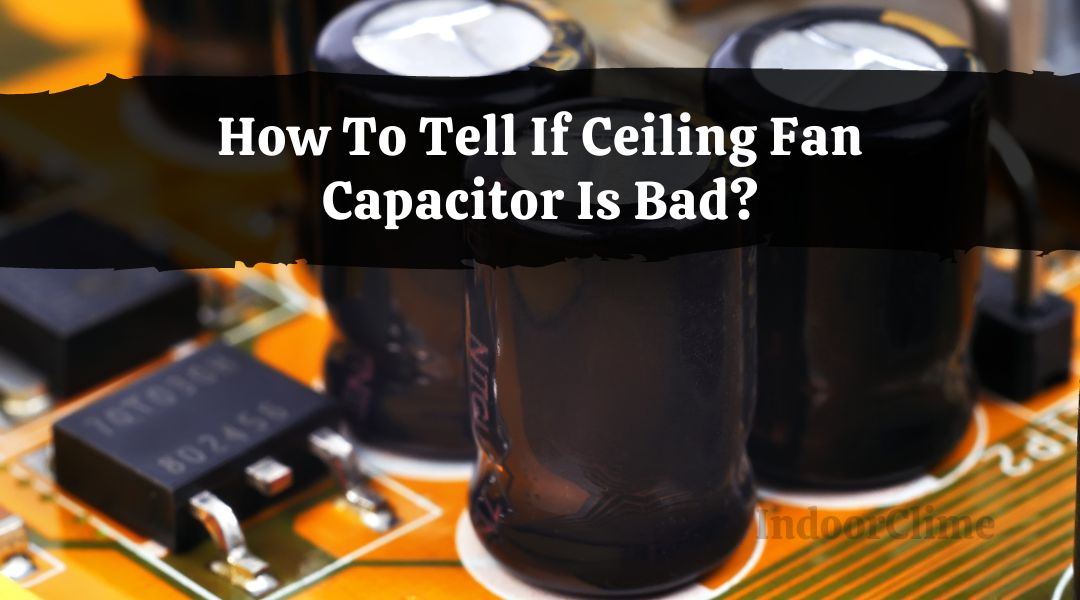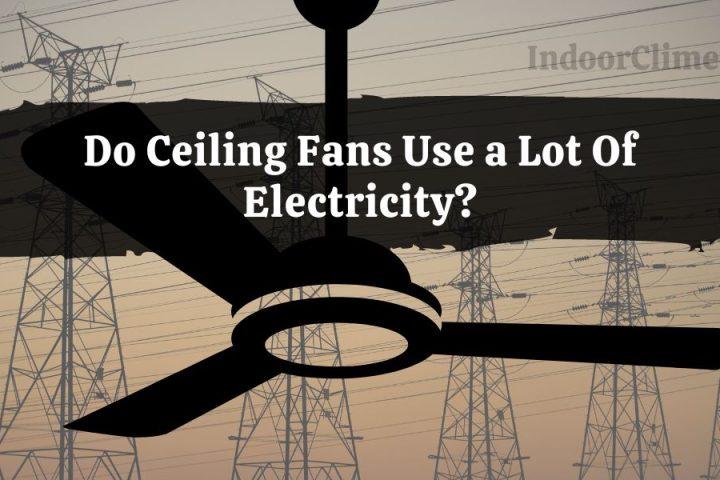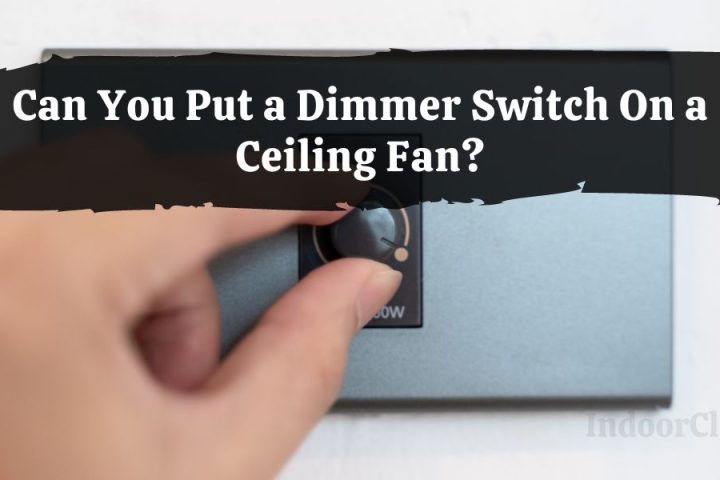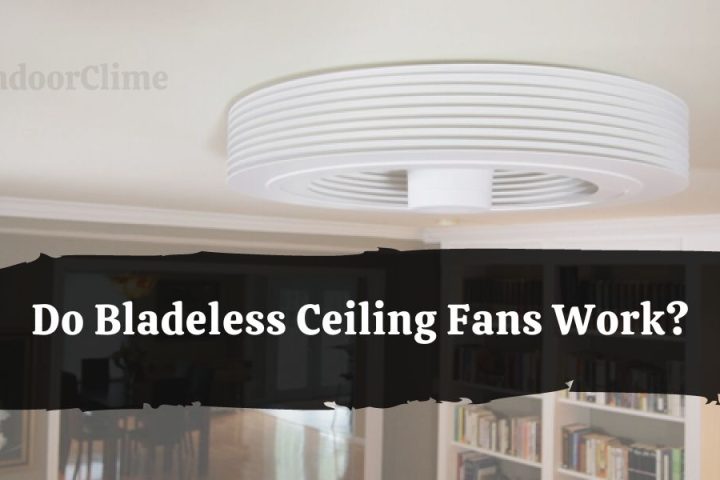The capacitor may have been visibly attached to each ceiling fan. The ceiling fan’s motor is started using this capacitor.
You can tell if the ceiling fan capacitor is bad as it may not function effectively due to overheating, excessive use, or voltage fluctuations. A capacitor may occasionally become damaged.
The causes of a defective capacitor, its symptoms, and the steps to determine if it is good or bad are all covered in this article.
What Are the Symptoms Of a Bad Capacitor For Ceiling Fans?

Depending on how it went bad, a bad capacitor can ruin your fan’s ability to function and pose a serious fire risk. Consider giving your ceiling fan capacitor a closer look if you detect any of these problems.
Here are the signs of a faulty capacitor in a ceiling fan:
1. Burning
Overheating will mostly produce melting or burning surrounding the capacitor, confirming that the capacitor is defective. However, when you examine the capacitor physically, you find plenty of melting or indications of burning.
By overheating, a capacitor can really “burn out.” If this happens, you can see melting or burning surrounding the capacitor. In most cases, this provides a quick diagnosis of a faulty capacitor.
2. The Fan Won’t Turn On.
The capacitor is damaged if the fan spins when the switch is turned on but does not begin spinning until the blades are manually pushed.
If you push the ceiling fan by hand, it will continue to spin even though there is no switch to turn it on. This may indicate that your capacitor struggles to cope with a phase shift.
It is essentially dead when you try to switch it on; nothing happens. Typically, the fan motor makes noise. The fan’s rotation can still be controlled with your hand. The capacitor’s inability to transition between the start and run coils is the culprit.
3. The Fan’s Slowly Rotating Blades.
A faulty capacitor may be one of the causes of the lower fan speed. By using a multimeter to test the capacitor, you can verify that. The speed of your ceiling fan has decreased from what it was.
Even though it’s not necessarily an indication of a damaged capacitor, you should test it with a multimeter if you can’t find any other explanation.
4. At Certain Speeds, the Fan Is Inoperative.
Speed controllers are uncommon in fans. Change the capacitor if the fan spins slowly or even stops for a brief period.
Your ceiling fan has several slow or ineffective speeds. Capacitors cause phase shifts; therefore, when you notice them, it’s nearly a sign that your capacitor is about to fail.
5. Bad Multimeter Readings
If unsure about the capacitor, you can use a multimeter to confirm it. Unpleasant readings on the multimeter indicate a defective capacitor.
Your capacitor’s tests are poor. For example, if you apply a multimeter to the capacitor, you require a new capacitor and receive a poor result.
What Happens When a Fan Capacitor Goes Bad?
If the capacitor malfunctions, the ceiling fan receives the same amount of power as usual. But because the capacitor is damaged, starting torque cannot be produced because the start winding does not get enough power.
The motor will attempt to run even though there is no phase difference between the two windings since there is zero starting torque. This issue will cause a humming noise to be heard.
Can You Run a Ceiling Fan Without a Capacitor?

The ceiling fan can be operated without a capacitor by manually turning the blades. This is because the ceiling fan begins to rotate in that direction when you manually turn the blades.
Since starting the ceiling fan manually is laborious, a capacitor is fitted to make it self-starting. This labor-intensive manual process is automated with a condenser connected to the ceiling fan.
The ceiling fan’s motor is equipped with two different types of windings. The start winding is the first, and the run winding is the second.
Most ceiling fans are single-phase appliances. The fan needs starting torque to turn. In the absence of a capacitor, it is impossible.
Therefore, the phase change between two windings is necessary for initiating torque. So, the capacitor and the starting winding are linked together in series.
Assume the motor circuit for the ceiling fan has no capacitor connected. This parallel connection of the beginning and running windings across the single phase AC supply voltage (120V in the US & 230V in the EU).
Instead of the revolving magnetic field required for torque and rotation, the current flowing through the winding inductors will produce a pulsing magnetic field (from 0 to 180°).
Because of the single-phase supply, just one rotating flux rotates concurrently in clockwise and anticlockwise directions.
In other words, the direction of the motor’s rotation alternates between clockwise and anticlockwise constantly after each half cycle (AC sine wave).
The double field revolving hypothesis states that both torques cancel after a half cycle. The resultant (net) rotating magnetic field, or zero beginning torque, would be zero. This is why single-phase induction motors and ceiling fans cannot start themselves.
How Many Years Do Capacitors Last?

Capacitors have a finite shelf life, just like everything else. Although they are generally made to endure for 20 years or more, several things can cause them to wear out sooner.
Your capacitor’s anticipated life duration may be significantly shortened if your ceiling fan cycles much more quickly than usual, is built using troublesome parts, or is undersized (as noted above).
Fortunately, it won’t break the bank if your capacitor goes out before your fan because these parts are quite cheap to replace.
The manufacturer specifies the design lifetime of electrolytic capacitors at the maximum rated ambient temperature, typically 105°C. This design lifetime can range from 1,000 hours to 10,000 hours or more. The component will endure longer in a particular application and temperature the longer the design lifetime.
Manufacturers provide formulas to calculate the lifetime in use. These are based on the Arrhenius equation, which describes how reaction rates vary with temperature. This establishes that the response rate doubles for every 10°C increase.
Accordingly, a capacitor rated for 5,000 hours at 105°C would have a service life of 10,000 at 95°C and 20,000 hours at 85°C. This means that the lifetime doubles with every 10°C decrease in temperature.
The steady evaporation of the electrolyte over time is the main factor in the deterioration and failure of electrolytic capacitors, which are accelerated at higher temperatures. Lower capacitance and increased effective series resistance are the effects (ESR).
As they age, capacitors constantly lose capacity. The capacitor’s leakage current rises as a result. Based on two crucial factors, electrolytic capacitors differ in their construction. These are the characteristics of the electrolyte and the electrode material (such as tantalum or niobium).
Can a Fan Capacitor Be Repaired?

No. A faulty capacitor itself cannot be repaired. The defective capacitor must be replaced to make it work again. It’s also important to remember that having a damaged capacitor can result in other electrical issues.
In more detail, it might result in burned wiring around the capacitor. This could cause a fire risk or reduce the effectiveness of your ceiling fan.
To resolve the issue fully, you must check the capacitor’s wiring to ensure it’s still in good shape. Inspect the capacitor’s voltage. The capacitor is probably broken if the voltage is within acceptable limits and there is no issue.
- Find and remove the capacitor from the ceiling fan (fuse box or breaker). To ensure the ceiling fan operates properly while replacing the condenser, it is recommended to leave it on.
- Utilize an electronic voltmeter to test the new capacitor.
- To test the capacitor, switch on the fan after connecting the cables. If it is broken, you must swap it out for an equivalent of the same size or larger.
- Call a repairman to have the fan rewired if you see poor wiring.
How Do You Fix a Capacitor On a Ceiling Fan?

You can fix a capacitor on a ceiling fan as you can find the replacement part. Knowing the replacement component is necessary before replacing a ceiling fan capacitor.
Speaking with the fan’s maker might be essential to get this information. Then start putting the new one in place of the old one by following the instructions below:
1. Before touching the wire, turn off the electricity to the fuse board or remove the circuit breaker and verify the voltage (usually not after disconnecting the power).
2. Observe the polarity and note the connections after removing the old capacitor.
Install the replacement capacitor and connect it using the wires from the old one.
3. Connect the blue wire to the second terminal of the capacitor and the red (live) wire from the ceiling fan to the first terminal of the replacement capacitor.
4. The red and blue wire should be connected, and the wire connector should have a wire nut and electric tap.
5. Connect the black (neutral) wire connector from the ceiling fan to the second slot. Don’t connect the capacitor to the neutral wire; instead, connect it exclusively to the red and black wires (or the blue and black wires, depending on the manufacturer and user manual). Otherwise, the fan will rotate counterclockwise or in the opposite direction (clockwise).
6. Connect the power supply’s live and neutral now. To check the ceiling fan, turn the main circuit breaker ON.
7. Connect after supplying the fuse board with power. Make sure the condenser is functioning properly by inspecting the ceiling fan.
Numerous symptoms can point to a damaged capacitor. You’ve seen a few of them up top. I hope I’ve answered all of your questions about faulty capacitors.
Remember, if you give electricity a chance to murder you, it will never miss it. Electricity is our enemy. While performing this course in practice, please read all warnings and instructions.





